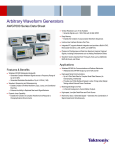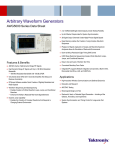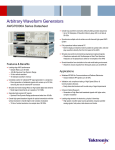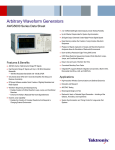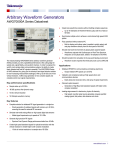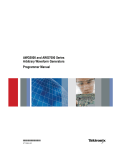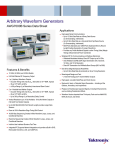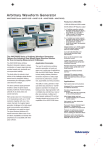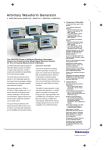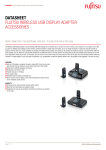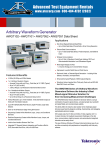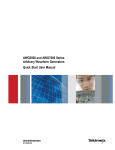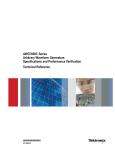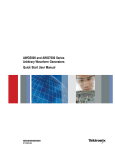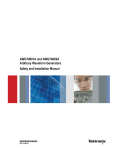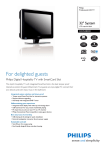Download Arbitrary Waveform Generators - AWG7000 Series
Transcript
Arbitrary Waveform Generators AWG7000 Series Data Sheet Vertical Resolution up to 10 bit Available Generate Signals up to 1 GHz Modulation Bandwidths with 54 dBc SFDR Deep Memory Enables the Creation of Long Complex Waveform Sequences Intuitive User Interface Shortens Test Time Integrated PC supports Network Integration and provides a Built-in DVD, Removable Hard Drive, LAN, eSATA, and USB Ports Playback of Oscilloscope and Real-time Spectrum Analyzer Captured Signals, including Enhancements such as Adding Predistortion Effects Waveform Vectors Imported from Third-party Tools such as MathCAD, MATLAB, Excel, and Others Applications Features & Benefits Wideband RF/MW Modulation Bandwidth Generates Complex Wideband Signals across a Frequency Range of up to 9.6 GHz Generates Modulation Bandwidths of up to 5.3 GHz (–3 dB) Waveform Sequencing and Subsequencing Enables Creation of Infinite Waveform Loops, Jumps, and Conditional Branches Enhance the Ability to Replicate Real-world Signal Behavior Dynamic Jump Capability Enables the Creation of Complex Waveforms that Respond to Changing External Environments Wideband RF/MW for Communications and Defense Electronics Wideband Direct RF/MW Output up to 9.6 GHz Carrier High-speed Serial Communications Up to 6 Gb/s Data Rate for Complex Serial Data Streams (4x Oversampling, Interleaved) Provides any Profile Multilevel Signals to allow Timing (Jitter) Margin Testing without External Power Combiners Mixed-signal Design and Test 2-channel Analog plus 4-channel Marker Outputs High-speed, Low-jitter Data/Pulse and Clock Source Real-world, Ideal, or Distorted Signals – Generates Any Combination of Signal Impairments Simultaneously Data Sheet Unparalleled Performance The need for performance arbitrary waveform generation is broad and spans over a wide array of applications. The industry-leading AWG7000 Series arbitrary waveform generators (AWG) represent a cutting edge benchmark in performance, sample rate, signal fidelity, and timing resolution. The ability to create, generate, or replicate either ideal, distorted, or “real-life” signals is essential in the design and testing process. The AWG7000 Series of AWGs, with up to 24 GS/s and 10-bit vertical resolution, delivers the industry's best signal stimulus solution for ever-increasing measurement challenges. This allows for easy generation of very complex signals, including complete control over signal characteristics. The capabilities of the AWG7000 Series are further enhanced by the addition of key features: Equation Editor The Equation Editor is an ASCII text editor that uses text strings to create waveforms by loading, editing, and compiling equation files. The editor provides control and flexibility to create more complex waveforms using customer-defined parameters. Waveform Sequencing and Subsequencing Real-time sequencing creates infinite waveform loops, jumps, and conditional branches for longer pattern-length generation suitable for replicating real-world behavior of serial transmitters. Dynamic Jump The Dynamic Jump capability enables the creation of complex waveforms by enabling the ability to dynamically jump to any predefined index in a waveform sequence. Users can define up to 256 distinct jump indexes that respond to changing external environments. LXI Class C Using the LXI Web Interface, you can connect to the AWG7000 Series through a standard web browser by simply entering the AWG's IP address in the address bar of the browser. The web interface enables viewing of instrument status and configuration, as well as status and modification of network settings. All web interaction conforms to the LXI Class C specification. Wideband RF Signal Generation Creating RF signals is becoming more and more complex, making it more difficult for RF engineers to accurately create the signals required for conformance and margin testing. When combined with RFXpress, the AWG7000 Series can address these tough design challenges. RFXpress is a software package that digitally synthesizes modulated baseband, IF, and RF signals taking signal generation to new levels by fully exploiting the wideband signal generation capabilities of the AWG7000 Series arbitrary waveform generators (AWGs). Together the AWG7000 and RFXpress provide engineers with “bandwidth on demand”, which is the ability to 2 www.tektronix.com/awg7000 AWG radar pulses created with AWG7000 and RFXpress. generate wideband modulated signals up to 5.3 GHz (–3 dB) anywhere within the 9.6 GHz frequency range. The latest digital RF technologies often exceed the capabilities of other test instruments because of the need to generate the wide-bandwidth and fast-changing signals that are increasingly seen in many RF applications such as radar, RF comms, OFDM, and UWB. When used in conjunction with RFXpress the AWG7000 Series supports a wide range of modulation formats and simplifies the task of creating complex RF waveforms. The AWG7000 Series instruments provide customers with ways to generate fully modulated baseband, intermediate frequency (IF) signals, or directly generated RF waveforms. Radar Signal Creation Generating advanced radar signals often demands exceptional performance from an AWG in terms of sample rate, analog bandwidth, and memory. The Tektronix AWG7000 Series sets a new industry standard for advanced radar signal generation, by delivering wide modulation bandwidths up to 5.3 GHz (–3 dB). With a sample rate of up to 24 GS/s the AWG7000 Series can directly generate RF signals never before possible from an AWG. In instances where IQ generation is desired, the AWG7000 offers the ability to oversample the signal, thereby improving signal quality. The AWG7000 and RFXpress are the perfect solution for creating complex radar signals. Customers are provided with the ultimate flexibility in creating custom radar pulse suites. Modulation types such as LFM,Barker and Polyphase Codes, Step FM, and Nonlinear FM are easily created using the AWG, and the flexibility of RFXpress enables the creation of waveforms requiring customer-defined modulation types. The AWG and RFXpress combo also has the ability to generate pulse trains with staggered PRI to resolve range and doppler ambiguity, frequency hopping for Electronic Counter-Counter Measures (ECCM), and pulse-to-pulse amplitude variation to simulate Swerling target models including antenna scan patterns, clutter, and multipath effects. Arbitrary Waveform Generators — AWG7000 Series Environment Signal Generation Radar signals must coexist with other commercial standard signals sharing the same spectrum and are still expected to perform with no performance degradation. This isn't unreasonable given its mission-critical operations. To meet this expectation, a radar designer has to thoroughly test all the corner cases at the design/debug stage. The AWG7000 and RFXpress Environment plug-in offers extreme flexibility to define and create these worst-case scenarios. You can specify up to 25 signals to define your environment, including WiMAX, WiFi, GSM, GSM-EDGE, EGPRS 2A, EGPRS2B, CDMA, W-CDMA, DVB-T, Noise, and CW Radar. This plug-in also allows you to seamlessly import signals from other RFXpress plug-ins (including Radar, Generic Signal, etc.), as well as from Matlab® and from Tektronix spectrum analyzers and oscilloscopes, into your environment. You can also configure PHY parameters of your standard-specific signals. You can define the carrier frequency, power, start time, and duration for all the signals in your environment, so you have full control over the way these signals interact/interfere with each other. Generic OFDM Creation In today's wireless world, OFDM is becoming the modulation method of choice for transmitting large amounts of digital data over short and medium distances. The need for wide bandwidths and multiple carriers create challenges for engineers who need to create OFDM signals to test their RF receivers. The AWG7000 Series, when coupled with RFXpress, allows users to configure every part of the OFDM signal definition. Engineers can build signals symbol-by-symbol to create a complete OFDM frame or let the RFXpress software choose default values for some signal aspects. The AWG/RFXpress combo supports a variety of data coding formats that include Reed Solomon, Convolution, and Scrambling. Users also have the ability to define each subcarrier in the symbol which can be configured independently for type, modulation, and base data. The RFXpress software gives visibility into all aspects of the OFDM signal by providing a symbol table that gives a summary of all the carriers in the selected symbol. OFDM packets/frames can be built by specifying the spacing between the symbols/frames and parts of the OFDM packets can be stressed by adding gated noise. Direct WiMedia signals are easily created with the AWG7000 and RFXpress. UWB-WiMedia (UWBCF/UWBCT) Ultra-Wideband (UWB) wireless is a growing technology that is designed for low-power, short-range wireless applications. UWB has emerged as the leading technology for applications like wireless Universal Serial Bus (USB). UWB radios, like generic OFDM radios, require wide signal bandwidths and multiple carriers, but UWB designs also require short-duration pulses and transmit Power Spectral Densities (PSDs) near the thermal noise floor which can make creating UWB test signals very difficult. Fortunately, the AWG7000 Series and RFXpress offer a solid solution for the generation of UWB test signals. The AWG7000 and RFXpress have the capability to digitally synthesize and generate signals in the UWB spectrum. For either custom UWB signal or ones defined for the latest WiMedia specification, the AWG7000 solution can recreate signals that are required to band hop in real time over a 1.6 GHz modulation bandwidth. The RFXpress software gives users complete control over the characteristics of their UWB signals including the preamble synchronization sequences, cover sequences, and TFCs. For WiMedia applications all six band groups (BG1 to BG6) can be generated in either IQ, IF, or direct RF signals, giving users 3 different options for creating/up-converting the signals when using an AWG7000 instrument. www.tektronix.com/awg7000 3 Data Sheet Easily create digital data impairments with the AWG7000 and SerialXpress. High-speed Serial Signal Generation Serial signals are made up entirely of simple ones and zeros – binary data. Historically engineers have used data generators to create digital signals. As clock rates have increased these simple ones and zeros have begun to look more like analog waveforms because embedded in the digital data are analog events. The zero rise time and the perfectly flat tops of textbook digital signals no longer represent reality. Electronic environments have noise, jitter, crosstalk, distributed reactances, power supply variations, and other shortcomings. Each takes its toll on the signal. A real-world digital “square wave” rarely resembles its theoretical counterpart. Since the AWG7000 Series is an analog waveform source it is the perfect single-box solution that is used to create digital data streams and mimic the analog imperfections that occur in real-world environments. The AWG7000 Series uses direct synthesis techniques which allow engineers to create signals that embody the effects of propagation through a transmission line. Rise times, pulse shapes, delays, and aberrations can all be controlled with the AWG7000 Series instruments. When used in conjunction with the SerialXpress software package, engineers are provided control over every aspect of their digital signals reaching speeds of up to 6 Gb/s. This is exactly what is needed for rigorous receiver testing requirements. 4 www.tektronix.com/awg7000 Digital data with de-emphasis added using the AWG7000 and SerialXpress. SerialXpress is an integrated SW tool that enables AWG7000 Series instruments to create a variety of digital data impairments such as jitter (Random, Periodic, Sinusoidal), noise, pre/de-emphasis, duty cycle distortion, Inter-symbol Interference (ISI), Duty Cycle Distortion (DCD), and Spread Spectrum Clocking (SSC). The transmission environments of both board and cables can be emulated using touchstone files uploaded into SerialXpress. The AWG7000 and SerialXpress solution also provides base pattern waveforms for many of today's high-speed serial applications such as SATA, Display Port, SAS, PCI-E, USB, and Fibre Channel. For high-speed serial applications the AWG7000 Series offers the industry's best solution for addressing challenging signal stimulus issues faced by digital designers who need to verify, characterize, and debug complex digital designs. The file-based architecture uses direct synthesis to create complex data streams and provides users with the simplicity, repeatability, and flexibility required to solve the toughest signal generation challenges in high-speed serial communication applications. Performance You Can Count On Depend on Tektronix to provide you with performance you can count on. In addition to industry-leading service and support, this product comes backed by a one-year warranty as standard. Arbitrary Waveform Generators — AWG7000 Series Characteristics Definitions Specifications (not noted) – Product characteristics described in terms of specified performance with tolerance limits which are warranted/guaranteed to the customer. Specifications are checked in the manufacturing process and in the Performance Verification section of the product manual with a direct measurement of the parameter. Typical (noted) – Product characteristics described in terms of typical performance, but not guaranteed performance. The values given are never warranted, but most units will perform to the level indicated. Typical characteristics are not tested in the manufacturing process or the Performance Verification section of the product manual. Nominal (noted) – Product characteristics described in terms of being guaranteed by design. Nominal characteristics are non-warranted, so they are not checked in the manufacturing process or the Performance Verification section of the product manual. AWG7122C Series Specifications General Characteristics Characteristic Digital to Analog Converter Sample rate (nominal) Resolution (nominal) Sin (x)/x Roll-off Sin (x)/x (–1 dB) Sin (x)/x (–3 dB) Normal: w/ Amplifier 2 Channel Direct: w/o Amplifier 2 Channel Wideband: Option 02 2 Channel Wideband: Option 06 2 Channel 10 MS/s to 12 GS/s 10 bit (no markers selected) or 8 bit (markers selected) 3.1 GHz 5.3 GHz Interleaved: Option 06 1 Channel 12 GS/s to 24 GS/s 6.2 GHz 10.6 GHz www.tektronix.com/awg7000 5 Data Sheet Frequency Domain Characteristics Normal: w/ Amplifier 2 Channel Output Frequency Characteristics Characteristic Direct: w/o Amplifier 2 Channel Wideband: Option 02 2 Channel Wideband: Option 06 2 Channel Interleaved: Option 06 1 Channel Effective Frequency Output Fmaximum (specified) is determined as "sample rate / oversampling rate" or "SR / 2.5" Fmaximum 4.8 GHz 9.6 GHz Effective Frequency Minimum frequency switching time from selected waveforms in sequence mode is determined as "1/Fmaximum" Switching Time Standard 106 μs Switching time (Ts) Option 08 (fast frequency switching) 208 ps 104 ps Switching time (Ts) Modulation Bandwidth Modulation bandwidth is defined as the lower of the sin(x)/x bandwidth or the calculated percentage of rise time bandwidth (as shown) Up to 400 MHz Up to 1.8 GHz Up to 3.1 GHz Up to 3.3 GHz (Zero On) Mod bandwidth (–1 dB) Up to 3.1 GHz (Zero Off) (typical) –1 dB BW = 0.923 × (–1 dB TrBW) Up to 680 MHz Up to 3.2 GHz Up to 5.3 GHz Up to 5.6 GHz (Zero On) Mod bandwidth (–3 dB) Up to 5.3 GHz (Zero Off) (typical) –3 dB BW = 0.913 × (–3 dB TrBW) AWG7122C Frequency Response (typical). 6 www.tektronix.com/awg7000 Arbitrary Waveform Generators — AWG7000 Series Normal: w/ Amplifier 2 Channel Output Amplitude Characteristics Characteristic Amplitude Range (typical) –22 dBm to 10 dBm Resolution (typical) Accuracy (typical) Output Flatness Flatness (typical) Output Match SWR (typical) AWG7122C Standard/Wideband Flatness (typical). Direct: w/o Amplifier 2 Channel Wideband: Option 02 2 Channel Wideband: Option 06 2 Channel Interleaved: Option 06 1 Channel Amplitude levels are measured as single-ended outputs Amplitude level will be 3 dBm higher when using differential (both) outputs –22 dBm to 4 dBm –2 dBm to 4 dBm Zero On: –8 dBm to –2 dBm Zero Off: –2 dBm to 4 dBm 0.01 dB At –2 dBm level, with no offset, ±0.3 dB Mathematically corrected for characteristic Sin (x)/x roll-off, uncorrected by external calibration methods ±1.0 dB, from 50 MHz to 4.8 GHz ±2.5 dB, from 50 MHz to 9.6 GHz DC to 1.5 GHz, 1.2:1 1.5 to 4.8 GHz, 1.7:1 DC to 1.5 GHz, 1.2:1 1.5 to 4.8 GHz, 1.3:1 4.8 to 9.6 GHz, 1.5:1 AWG7122C Interleave Flatness (typical). www.tektronix.com/awg7000 7 Data Sheet Time Domain Characteristics Normal: w/ Amplifier 2 Channel Characteristic Direct: w/o Amplifier 2 Channel Wideband: Option 02 2 Channel Wideband: Option 06 2 Channel Interleaved: Option 06 1 Channel Data Rate Characteristics Data Rate Bit rate (nominal) Bit rate determined as "sample rate / 4 points per cycle", allowing full impairment generation 3 Gb/s 6 Gb/s Rise/Fall Time Characteristics Rise/Fall Time Tr/Tf (typical) Rise Time Bandwidth Tr bandwidth (–1 dB) (typical) –1 dB BW = 0.197/Tr Tr bandwidth (–3 dB) (typical) –3 dB BW = 0.339/Tr Low-pass filter Rise/Fall time measured at 20% to 80% levels, related by a factor of 0.75 to the industry standard of 10% to 90% levels 75 ps 350 ps 35 ps 42 ps Rise-time bandwidth converted from rise-time, assumed Gaussian transition, characteristics through analog output circuitry and cabling 430 MHz 2.0 GHz 4.3 GHz 3.6 GHz 750 MHz 3.5 GHz 7.5 GHz 6.2 GHz — Bessel Type: 50 and 200 MHz Output Amplitude Characteristics Amplitude Range (typical) 100 mVp-p to 4.0 Vp-p 1.0 mV At 0.5 V, with no offset, ±(3% of amplitude ±2 mV) Resolution (typical) Accuracy (typical) Offset Range (typical) Resolution (typical) Accuracy (typical) 8 Amplitude levels are measured between differential outputs (+) to (–) For single-ended output the amplitude level will be one-half the voltage levels below 100 mVp-p to 2.0 Vp-p 1.0 Vp-p to 2.0 Vp-p ±0.5 V 1.0 mV At minimum amplitude, ±(2.0% of offset ±10 mV) www.tektronix.com/awg7000 Zero On: 500 mVp-p to 1.0 Vp-p Zero Off: 1.0 Vp-p to 2.0 Vp-p Zero On: ±(8% of level ±2 mV) Zero Off: ±(4% of level ±2 mV) — — — Arbitrary Waveform Generators — AWG7000 Series Common Characteristics Normal: w/ Amplifier 2 Channel Output Distortion Characteristics Characteristic Spurious Free Dynamic Range (SFDR) SFDR (typical) DC to 1.0 GHz carrier 1.0 to 2.4 GHz carrier 2.4 to 3.5 GHz carrier 3.5 to 4.8 GHz carrier 4.8 to 9.6 GHz carrier Spurious Free Dynamic Range (SFDR) SFDR (typical) DC to 1.0 GHz bandwidth (–1 dB) DC to 2.4 GHz bandwidth (–1 dB) DC to 3.5 GHz bandwidth (–1 dB) Direct: w/o Amplifier 2 Channel Wideband: Option 02 2 Channel Wideband: Option 06 2 Channel Interleaved: Option 06 1 Channel SFDR is determined as a function of the directly generated carrier frequency. Harmonics not included Clock: 12 GS/s, 10-bit operation Frequency: 50 MHz to 4.8 GHz Level: 4 dBm (1 Vp-p) Offset: None –54 –46 –38 –30 Clock: 24 GS/s, 10-bit operation Frequency: 50 MHz to 9.6 GHz Level: –2 dBm (0.5 Vp-p) dBc dBc dBc dBc — –26 dBc When viewed as a modulation bandwidth and used with external frequency up-conversion, the specifications will hold and be independent of carrier frequency with proper conversion circuitry design. Harmonics not included Clock: 24 GS/s, 10-bit Clock: 12 GS/s, 10-bit operation operation Modulation Bandwidth: Up to 2.5 GHz Modulation Bandwidth: Level: 4 dBm (1 Vp-p) Up to 3.5 GHz Offset: None Level: –2 dBm (0.5 Vp-p) –54 dBc –46 dBc — –38 dBc www.tektronix.com/awg7000 9 Data Sheet Characteristic Normal: w/ Amplifier 2 Channel Harmonic Distortion Harmonics (typical) Nonharmonic Distortion < –35 dBc Phase Noise (typical) AWG7122C Standard/Wideband Phase Noise (typical). www.tektronix.com/awg7000 Wideband: Option 02 2 Channel Wideband: Option 06 2 Channel Clock: 12 GS/s, 10-bit operation 32-point waveform 375 MHz output Amplitude: 4 dBm (1 Vp-p) Offset: None Spurious (typical) Phase Noise Distortion 10 Direct: w/o Amplifier 2 Channel < –42 dBc Clock: 12 GS/s, 10-bit operation 32-point waveform 375 MHz output Amplitude: 4 dBm (1 Vp-p) Offset: None < –50 dBc Clock: 12 GS/s, 10-bit operation 32-point waveform 375 MHz output Amplitude: 4 dBm (1 Vp-p) at 0 offset < –90 dBc/Hz at 10 kHz offset AWG7122C Interleave Phase Noise (typical). Interleaved: Option 06 1 Channel Clock: 24 GS/s, 10-bit operation 32-point waveform 750 MHz output Amplitude: –2 dBm (0.5 Vp-p) < –40 dBc Clock: 24 GS/s, 10-bit operation 32-point waveform 750 MHz output Amplitude: –2 dBm (0.5 Vp-p) < –45 dBc Clock: 24 GS/s, 10-bit operation 32-point waveform 750 MHz output Amplitude: –2 dBm (0.5 Vp-p) at 0 offset < –85 dBc/Hz at 10 kHz offset Arbitrary Waveform Generators — AWG7000 Series Normal: w/ Amplifier 2 Channel Characteristic Jitter Random jitter (typical) RMS value Total jitter (typical) P-P value Direct: w/o Amplifier 2 Channel Wideband: Option 02 2 Channel Wideband: Option 06 2 Channel Interleaved: Option 06 1 Channel 1010 clock pattern 1.6 ps 50 ps at 0.5 Gb/s 30 ps at 3 Gb/s 0.9 ps 215 – 1 data pattern (at 10–12 BER) 20 ps from 2 to 6 Gb/s Output Pulse Characteristics Pulse Response Tr/Tf (typical) Timing skew (typical) Delay from marker output (typical) Interleave skew adjustment (typical) Interleave level adjustment (typical) 350 ps 75 ps 35 ps <20 ps (between each channel) (+) Pos and (–) Neg outputs 50 MHz: 10.15 ns ±0.15 ns 200 MHz: 4.05 ns ±0.05 ns 25 ns ±0.05 ns 0.58 ns ±0.05 ns — — 42 ps <12 ps (between each channel) (+) Pos and (–) Neg outputs 0.85 ns ±0.05 ns Skew adjust: ±180 degree against sample rate (e.g. 24 GS/s: 83 ps = 360 degrees with 0.1 degree resolution) Level adjust: 1 mV resolution www.tektronix.com/awg7000 11 Data Sheet Definitions Specifications (not noted) – Product characteristics described in terms of specified performance with tolerance limits which are warranted/guaranteed to the customer. Specifications are checked in the manufacturing process and in the Performance Verification section of the product manual with a direct measurement of the parameter. Typical (noted) – Product characteristics described in terms of typical performance, but not guaranteed performance. The values given are never warranted, but most units will perform to the level indicated. Typical characteristics are not tested in the manufacturing process or the Performance Verification section of the product manual. Nominal (noted) – Product characteristics described in terms of being guaranteed by design. Nominal characteristics are non-warranted, so they are not checked in the manufacturing process or the Performance Verification section of the product manual. AWG7082C Series Specifications General Characteristics Characteristic Normal: w/ Amplifier 2 Channel Digital to Analog Converter Sample rate (nominal) Resolution (nominal) Sin (x)/x Roll-off Sin (x)/x (–1 dB) Sin (x)/x (–3 dB) 12 www.tektronix.com/awg7000 Direct: w/o Amplifier 2 Channel Wideband: Option 02 2 Channel Wideband: Option 06 2 Channel 10 MS/s to 8 GS/s 10 bit (no markers selected) or 8 bit (markers selected) 2.1 GHz 3.5 GHz Interleaved: Option 06 1 Channel 8 GS/s to 16 GS/s 4.2 GHz 7.0 GHz Arbitrary Waveform Generators — AWG7000 Series Frequency Domain Characteristics Normal: w/ Amplifier 2 Channel Output Frequency Characteristics Characteristic Direct: w/o Amplifier 2 Channel Wideband: Option 02 2 Channel Wideband: Option 06 2 Channel Interleaved: Option 06 1 Channel Effective Frequency Output Fmaximum (specified) is determined as "sample rate / oversampling rate" or "SR / 2.5" Fmaximum 3.2 GHz 6.4 GHz Effective Frequency Minimum frequency switching time from selected waveforms in sequence mode is determined as "1/Fmaximum" Switching Time Standard 160 μs Switching time (Ts) Option 08 (fast frequency switching) 313 ps 156 ps Switching time (Ts) Modulation Bandwidth Modulation bandwidth is defined as the lower of the sin(x)/x bandwidth or the calculated percentage of rise time bandwidth (as shown) Up to 400 MHz Up to 1.8 GHz Up to 2.1 GHz Up to 3.3 GHz (Zero On) Mod bandwidth (–1 dB) Up to 3.1 GHz (Zero Off) (typical) –1 dB BW = 0.923 × (–1 dB TrBW) Up to 680 MHz Up to 3.2 GHz Up to 3.5 GHz Up to 5.6 GHz (Zero On) Mod bandwidth (–3 dB) Up to 5.3 GHz (Zero Off) (typical) –3 dB BW = 0.913 × (–3 db TrBW) AWG7082C Frequency Response (typical). www.tektronix.com/awg7000 13 Data Sheet Normal: w/ Amplifier 2 Channel Output Amplitude Characteristics Characteristic Amplitude Range (typical) –22 dBm to 10 dBm Resolution (typical) Accuracy (typical) Output Flatness Flatness (typical) Output Match SWR (typical) AWG7082C Standard/Wideband Flatness (typical). 14 www.tektronix.com/awg7000 Direct: w/o Amplifier 2 Channel Wideband: Option 02 2 Channel Wideband: Option 06 2 Channel Amplitude levels are measured as single-ended outputs Amplitude level will be 3 dBm higher when using differential (both) outputs –22 dBm to 4 dBm –2 dBm to 4 dBm Interleaved: Option 06 1 Channel Zero On: –8 dBm to –2 dBm Zero Off: –2 dBm to 4 dBm 0.01 dB At –2 dBm level, with no offset, ±0.3 dB Mathematically corrected for characteristic Sin (x)/x roll-off, uncorrected by external calibration methods ±1.0 dB, from 50 MHz to 3.2 GHz ±2.5 dB, from 50 MHz to 6.4 GHz DC to 1.5 GHz, 1.2:1 DC to 1.5 GHz, 1.2:1 1.5 to 3.2 GHz, 1.7:1 1.5 to 4.8 GHz, 1.3:1 4.8 to 6.4 GHz, 1.5:1 AWG7082C Interleave Flatness (typical). Arbitrary Waveform Generators — AWG7000 Series Time Domain Characteristics Normal: w/ Amplifier 2 Channel Characteristic Direct: w/o Amplifier 2 Channel Wideband: Option 02 2 Channel Wideband: Option 06 2 Channel Interleaved: Option 06 1 Channel Data Rate Characteristics Data Rate Bit rate (nominal) Bit rate determined as "sample rate / 4 points per cycle", allowing full impairment generation 2 Gb/s 4 Gb/s Rise/Fall Time Characteristics Rise/Fall Time Tr/Tf (typical) Rise-time Bandwidth Tr bandwidth (–1 dB) (typical) –1 dB BW = 0.197/Tr Tr bandwidth (–3 dB) (typical) –3 dB BW = 0.339/Tr Low-pass filter Rise/Fall time measured at 20% to 80% levels, related by a factor of 0.75 to the industry standard of 10% to 90% levels 75 ps 350 ps 35 ps 42 ps Rise-time bandwidth converted from rise-time, assumed Gaussian transition, characteristics through analog output circuitry and cabling 430 MHz 2.0 GHz 4.3 GHz 3.6 GHz 750 MHz 3.5 GHz 7.5 GHz 6.2 GHz — Bessel Type: 50 and 200 MHz Output Amplitude Characteristics Amplitude Range (typical) 100 mVp-p to 4.0 Vp-p 1.0 mV At 0.5 V, with no offset, ±(3% of amplitude ±2 mV) Resolution (typical) Accuracy (typical) Offset Range (typical) Resolution (typical) Accuracy (typical) Amplitude levels are measured between differential outputs (+) to (–) Single-ended output amplitude level will be one-half the voltage levels below 100 mVp-p to 2.0 Vp-p 1.0 Vp-p to 2.0 Vp-p ±0.5 V 1.0 mV At minimum amplitude, ±(2.0% of offset ±10 mV) Zero On: 500 mVp-p to 1.0 Vp-p Zero Off: 1.0 Vp-p to 2.0 Vp-p Zero On: ±(8% of level ±2 mV) Zero Off: ±(4% of level ±2 mV) — — — www.tektronix.com/awg7000 15 Data Sheet Common Characteristics Normal: w/ Amplifier 2 Channel Output Distortion Characteristics Characteristic Spurious Free Dynamic Range (SFDR) SFDR (typical) DC to 1.0 GHz carrier 1.0 to 2.4 GHz carrier 2.4 to 3.5 GHz carrier 3.5 to 4.8 GHz carrier 4.8 to 6.4 GHz carrier Spurious Free Dynamic Range (SFDR) SFDR (typical) DC to 1.0 GHz bandwidth (–1 dB) DC to 2.4 GHz bandwidth (–1 dB) DC to 3.5 GHz bandwidth (–1 dB) 16 www.tektronix.com/awg7000 Direct: w/o Amplifier 2 Channel Wideband: Option 02 2 Channel Wideband: Option 06 2 Channel Interleaved: Option 06 1 Channel SFDR is determined as a function of the directly generated carrier frequency. Harmonics not included Clock: 12 GS/s, 10-bit operation Frequency: 50 MHz to 3.2 GHz Level: 4 dBm (1 Vp-p) Offset: None Clock: 24 GS/s, 10-bit operation Frequency: 50 MHz to 6.4 GHz Level: –2 dBm (0.5 Vp-p) –54 dBc –46 dBc –40 dBc — — –32 dBc –28 dBc When viewed as a modulation bandwidth and used with external frequency up-conversion, the specifications will hold and be independent of carrier frequency with proper conversion circuitry design. Harmonics not included Clock: 16 GS/s, 10-bit Clock: 8 GS/s, 10-bit operation operation Modulation Bandwidth: Up to 1.9 GHz Modulation Bandwidth: Level: 4 dBm (1 Vp-p) Up to 3.0 GHz Offset: None Level: –2 dBm (0.5 Vp-p) –54 dBc –46 dBc — –38 dBc Arbitrary Waveform Generators — AWG7000 Series Characteristic Normal: w/ Amplifier 2 Channel Harmonic Distortion Harmonics (typical) Nonharmonic Distortion Direct: w/o Amplifier 2 Channel Wideband: Option 02 2 Channel Wideband: Option 06 2 Channel Clock: 8 GS/s, 10-bit operation 32-point waveform 250 MHz output Amplitude: 4 dBm (1 Vp-p) Offset: None < –35 dBc Spurious (typical) Phase Noise Distortion Phase Noise (typical) AWG7082C Standard/Wideband Phase Noise (typical). < –42 dBc Clock: 8 GS/s, 10-bit operation 32-point waveform 250 MHz output Amplitude: 4 dBm (1 Vp-p) Offset: None < –50 dBc Clock: 8 GS/s, 10-bit operation 32-point waveform 250 MHz output Amplitude: 4 dBm (1 Vp-p) at 0 offset < –90 dBc/Hz at 10 kHz offset Interleaved: Option 06 1 Channel Clock: 16 GS/s, 10-bit operation 32-point waveform 500 MHz output Amplitude: –2 dBm (0.5 Vp-p) < –40 dBc Clock: 16 GS/s, 10-bit operation 32-point waveform 500 MHz output Amplitude: –2 dBm (0.5 Vp-p) < –45 dBc Clock: 16 GS/s, 10-bit operation 32-point waveform 500 MHz output Amplitude: –2 dBm (0.5 Vp-p) at 0 offset < –85 dBc/Hz at 10 kHz offset AWG7082C Interleave Phase Noise (typical). www.tektronix.com/awg7000 17 Data Sheet Normal: w/ Amplifier 2 Channel Characteristic Jitter Random jitter (typical) RMS value Total jitter (typical) P-P value Direct: w/o Amplifier 2 Channel Wideband: Option 02 2 Channel Wideband: Option 06 2 Channel Interleaved: Option 06 1 Channel 1010 clock pattern 1.6 ps 50 ps at 0.5 Gb/s 30 ps at 2 Gb/s 0.9 ps 215 – 1 data pattern (at 10–12 BER) 20 ps from 2 to 4 Gb/s Output Pulse Characteristics Pulse Response Tr/Tf (typical) Timing skew (typical) Delay from marker output (typical) Interleave skew adjustment (typical) 350 ps 50 MHz: 10.15 ns ±0.15 ns 200 MHz: 4.05 ns ±0.05 ns Interleave level adjustment (typical) 18 75 ps 35 ps <20 ps (between each channel) (+) Pos and (–) Neg outputs www.tektronix.com/awg7000 2.25 ns ±0.05 ns 0.58 ns ±0.05 ns — — 42 ps <12 ps (between each channel) (+) Pos and (–) Neg outputs 0.85 ns ±0.05 ns Skew adjust: ±180 degree against sample rate (e.g. 24 GS/s: 83 ps = 360 degrees with 0.1 degree resolution) Level adjust: 1 mV resolution Arbitrary Waveform Generators — AWG7000 Series AWG7000C Series Common Features Common Hardware Characteristics Characteristic Number of Outputs Output connector Output impedance (nominal) Waveform Length Number of Waveforms Sequence Length/Counter Run Modes Continuous Triggered Gated Sequence Jump Sampling Clock Resolution Accuracy Internal Trigger Generator Range Resolution Output Skew Control Range Resolution Accuracy Normal: w/ Amplifier 2 Channel Direct: w/o Amplifier 2 Channel Wideband: Option 02 2 Channel Wideband: Option 06 2 Channel 2 channels, non-interleave Differential, SMA (front panel) 50 Ω Standard – to 32M points Extended memory – to 64M points Interleaved: Option 06 1 Channel 1 channel, interleave Standard – to 64M points Extended memory – to 128M points 1 to 16,200 1 to 16,000 steps, 1 to 65,536 count Waveform is iteratively output. If a sequence is defined, the sequence order and repeat functions are applied Waveform is output only once when an internal, external, programmatic (GPIB, LAN), or manual trigger is received Waveform begins output when gate is "True" and resets when gate is "False" Waveform is output as defined by the sequence selected Synchronous and asynchronous 8 digits Within ±(1 ppm + Aging), Aging: Within ±1 ppm per year 1.0 μs to 10.0 s 3 digits, 0.1 μs minimum –100 to 100 ps 1 ps ±(10% of setting + 10 ps) www.tektronix.com/awg7000 19 Data Sheet Common Software Characteristics Normal: w/ Amplifier 2 Channel Characteristic Operating System / Peripherals / IO Display Characteristics Waveform File Import Capability Wideband: Option 02 2 Channel Wideband: Option 06 2 Channel Interleaved: Option 06 1 Channel Windows 7 4 GB memory 300 GB Solid State Drive (std) / 1 TB Mechanical Hard Disk Drive (opt) (rear-panel removable, optional front mount kit) CD/DVD drive (front panel) Included USB compact keyboard and mouse USB 2.0 compliant ports (6 total – 2 front, 4 rear) PS/2 mouse and keyboard connections (rear panel) RJ-45 Ethernet connector (rear panel) supports 10/100/1000BASE-T DVI-I Video (rear panel) for external monitor eSATA (rear panel) LED backlit monitor with touch screen, 10.4 in. (264 mm) 1024 × 768 (V) XGA Import waveform format by series: *.AWG file created by Tektronix AWG5000 or AWG7000 Series *.PAT, *.SEQ, *.WFM and *.EQU file formats created by Tektronix arbitrary waveform generators such as the AWG400/500/600/700 Series *.IQT and *.TIQ files from Tektronix real-time spectrum analyzer *.TFW file created by Tektronix AFG3000 Series arbitrary/function generators *.DTG file created by Tektronix DTG5000 Series data timing generators *.WFM or *.ISF file created by Tektronix TDS/DPO Series oscilloscopes text file (*.TXT) Export waveform format by series: Tektronix AWG400/500/600/700 (*.wfm or *.pat) and text format IVI-COM driver, MATLAB library Waveform File Export Capability Software Driver for Third-party Applications Instrument Control / Data Transfer GPIB Ethernet TekLink LAN eXtensions for Instrumentation (LXI) 20 Direct: w/o Amplifier 2 Channel www.tektronix.com/awg7000 Remote control and data transfer (conforms to IEEE-Std 488.1, compatible with IEEE-Std 488.2 and SCPI-1999.0) Remote control and data transfer (conforms to IEEE-Std 802.3) Remote control and data transfer (proprietary bus for Tektronix product high-speed interconnection and communication) Class LXI Class C Version 1.3 Arbitrary Waveform Generators — AWG7000 Series Auxiliary Outputs Characteristic Markers Number Style Connector Impedance Level (into 50 Ω) Window Amplitude Resolution Accuracy Rise/Fall time (20% to 80%) Timing skew Intra-skew (typical) In-channel (typical) Delay control Range Resolution Accuracy Jitter Random RMS (typical) Total p-p (typical) 10 MHz Reference Out Amplitude Connector Impedance Synchronization Clock Output Frequency Amplitude DC Outputs Number Range Resolution Accuracy Connector Current (max) Normal: w/ Amplifier 2 Channel Direct: w/o Amplifier 2 Channel Wideband: Option 02 2 Channel Wideband: Option 06 2 Channel Interleaved: Option 06 1 Channel Total: 4 (2 per channel) Differential SMA (front panel) 50 Ω Amplitude levels are measured between differential outputs (+) to (–) Single-ended output amplitude level will be one-half the voltage levels below –2.8 V to 2.8 V 1.0 Vp-p to 2.8 Vp-p 10 mV ±(10% of setting + 75 mV) 45 ps (1.0 Vp-p, Hi: 1.0 V, Lo: 0.0 V) Total: 2 (2 per channel) <13 ps (between each channel (+) Pos and (–) Neg output) <30 ps (between Marker 1 and Marker 2 outputs) 0 to 300 ps 1 ps ±(5% of setting + 50 ps) 1 ps 30 ps (215 – 1 PN pattern at 10–12 BER) 1.2 Vp-p into 50 Ω, maximum 2.5 V open BNC (rear panel) 50 Ω, AC coupled 1/64 of the sample clock frequency 1.0 Vp-p into 50 Ω 4, independently controlled –3.0 to 5.0 V 10 mV ±(3% of setting + 120 mV) 2×4 pin header (front panel) ±30 mA www.tektronix.com/awg7000 21 Data Sheet Auxiliary Inputs Characteristic Normal: w/ Amplifier 2 Channel Direct: w/o Amplifier 2 Channel Wideband: Option 02 2 Channel Wideband: Option 06 2 Channel Interleaved: Option 06 1 Channel Trigger / Gate In Polarity Pos or Neg Range 50 Ω: ±5 V, 1 kΩ: ±10 V Connector BNC (front panel) Impedance 50 Ω, 1 kΩ Threshold Level –5.0 V to 5.0 V Resolution 0.1 V Trigger to output uncertainty Asynchronous Between internal/external clock and trigger timing: 0.5 ns at 12 GS/s, 0.7 ns at 10 GS/s, 0.8 ns at 9 GS/s, 0.9 ns at 8 GS/s, 1.0 ns at 6 GS/s (typical) Synchronous (typical) Between external clock and trigger timing: 12 GS/s, X1 clock divider, synchronous trigger mode with specific timing (120 psp-p, 30 psRMS) Synchronous (typical) Between external 10 MHz reference and trigger timing: 12 GS/s setting, synchronous trigger mode with specific timing (120 psp-p, 30 psRMS) Synchronous (typical) Between external variable reference and trigger timing: 2n (n: integer) clock reference, synchronous trigger and specific timing (50 psp-p, 10 psRMS) Trigger mode Minimum pulse width 20 ns 832 × sampling period – 100 ns Trigger hold-off Delay to output 128 × sampling period + 250 ns Gated mode Minimum pulse width 1024 × sampling period + 10 ns Delay to output 640 × sampling period + 260 ns Dynamic Jump Connector 15-pin DSUB on rear panel Level TTL +5 V compliant inputs, 3.3 V LV CMOS level Impedance Pull up to 3.3 V by 1 kΩ resistor Must strobe jump destination Strobe Event In Polarity Pos or Neg Range 50 Ω: ±5 V, 1 kΩ: ±10 V Connector BNC (front panel) Impedance 50 Ω, 1 kΩ Threshold Level –5.0 to 5.0 V Resolution 0.1 V Sequence mode Minimum pulse width 20 ns 900 × sampling period + 150 ns Event hold-off Delay to output 1024 × sampling period + 280 ns (Jump timing: asynchronous jump) 22 www.tektronix.com/awg7000 Arbitrary Waveform Generators — AWG7000 Series Normal: w/ Amplifier 2 Channel Characteristic Direct: w/o Amplifier 2 Channel External Clock In Input voltage range Frequency range Clock divider Connector Impedance Fixed Reference Clock In Input voltage range Frequency range Connector Impedance Variable Reference Clock In Input voltage range Frequency range Multiplier rate Connector Impedance Wideband: Option 02 2 Channel Interleaved: Option 06 1 Channel 1.4 Vp-p to 2.2 Vp-p, 7 dBm to 11 dBm 6 GHz to 12 GHz (acceptable frequency drift of ±0.1%) 1/1, 1/2, 1/4...1/256 SMA (rear panel) 50 Ω, AC coupled 0.2 Vp-p to 3.0 Vp-p 10 MHz, 20 MHz, 100 MHz (within ±0.1%) BNC (rear panel) 50 Ω, AC coupled 0.2 Vp-p to 3.0 Vp-p 5 MHz to 800 MHz (acceptable frequency drift is ±0.1%) 1 to 2400 BNC (rear panel) 50 Ω, AC coupled Physical Characteristics 2 to 4800 Environmental Characteristics Dimension mm in. Characteristic Height Width Depth 245 465 500 9.6 18.0 19.7 Weight kg lb. Net (instrument) Net (with packaging) 19 28 41.9 61.7 Temperature Operational Nonoperational Humidity Operational Mechanical Cooling Clearance cm in. Top/Bottom Side Rear 2 15 7.5 0.8 6 3 Power Supply Rating Consumption Wideband: Option 06 2 Channel 100 to 240 V AC, 47 to 63 Hz 450 Watts Nonoperational Altitude Operational Nonoperational Vibration Sine Operational Nonoperational Random Operational Nonoperational Mechanical Shock Operational Nonoperational Regulatory Safety Description 10 to 40 °C 20 to 60 °C 5% to 80% relative humidity (% RH) at up to 30 °C, 5% to 45% relative humidity above 30 °C up to 50 °C 5% to 90% relative humidity (% RH) at up to 30 °C, 5% to 45% relative humidity above 30 °C up to 50 °C Up to 10,000 ft. (3,048 m) Up to 40,000 ft. (12,192 m) 0.33 mm p-p (0.013 in p-p) constant displacement, 5 to 55 Hz NA 0.27 g RMS, 5 to 500 Hz, 10 minutes per axis 2.28 g RMS, 5 to 500 Hz, 10 minutes per axis Half-sine mechanical shocks, 30 g peak, 11 ms duration, 3 drops in each direction of each axis Half-sine mechanical shocks, 10 g peak, 11 ms duration, 3 drops in each direction of each axis UL61010-1, CAN/CSA-22.2, No.61010-1-04, EN61010-1, IEC61010-1 EN55011 (Class A), IEC61000-3-2, IEC61000-3-3 IEC61326, IEC61000-4-2/3/4/5/6/8/11 Emissions Immunity Regional certifications Europe EN61326 Australia / New AS/NZS 2064 Zealand www.tektronix.com/awg7000 23 Data Sheet Ordering Information International Power Plugs Arbitrary Waveform Generator Option Description Opt. Opt. Opt. Opt. Opt. Opt. Opt. Opt. Opt. Opt. North America Universal Euro United Kingdom Australia Switzerland Japan China India Brazil No power cord or AC adapter AWG7122C 12.0 GS/s (24 GS/s interleaved), 8/10 bit, 32M point, 2-channel arbitrary waveform generator. AWG7082C 8.0 GS/s (16 GS/s interleaved), 8/10 bit, 32M point, 2-channel arbitrary waveform generator. All Models Include: Accessory pouch, front cover, USB mouse, compact USB keyboard, lead set for DC output, AWG7000C Series product software CD and instructions, documentation CD with browser, Quick Start User Manual and registration card, Certificate of Calibration, power cable, and 50 Ω SMA terminator (3 ea), one-year warranty. A0 A1 A2 A3 A5 A6 A10 A11 A12 A99 Note: Please specify power cord and language option at time of order. Language Options Instrument Options Product Options Option AWG7122C, AWG7082C Opt. 01 Waveform record length expansion (from 32M point to 64M point) Wide bandwidth output (alternative output) Removable Mechanical HDD (1 TB) Interleaved output at 24 GS/s (AWG7122C), 16 GS/s (AWG7082C) (includes Opt. 02 – Wide bandwidth output) Fast sequence switching Subsequencing and Dynamic Jump option (subsequencing files created for legacy AWG400, AWG500, AWG600, and AWG700 instrument are compatible with this option) Adds RFXpress (RFX100) software to the AWG Adds Radar Signal Generation to RFXpress (requires Opt. RFX) Adds S-parameter Emulation to RFXpress (requires Opt. RFX) Adds OFDM Signal Generation to RFXpress (requires Opt. RFX) Adds Environment Signal Generation to RFXpress (requires Opt. RFX) Bundling Option – Opt. ENV + Opt. RDR (requires Opt. RFX) Bundling Option – Opt. ENV + Opt. RDR + Opt. OFDM (requires Opt. RFX) Bundling Option – Opt. ENV + Opt. RDR + Opt. OFDM + Opt. SPARA (requires Opt. RFX) Bundling Option – Opt. ENV + Opt. RDR + Opt. OFDM + Opt. SPARA + Opt. UWBCT (requires Opt. RFX) Adds UWB-WiMedia Conformance Signal Generation to RFXpress (requires Opt. RFX) Adds UWB-WiMedia Custom and Conformance Signal Generation to RFXpress (requires Opt. RFX, includes Opt. UWBCF) Opt. 02 Opt. 05 Opt. 06 Opt. 08 Opt. 09 Opt. RFX Opt. RDR Opt. SPARA Opt. OFDM Opt. ENV Opt. ENV01 Opt. ENV02 Opt. ENV03 Opt. ENV04 Opt. UWBCF Opt. UWBCT 24 www.tektronix.com/awg7000 Option Description Opt. Opt. Opt. Opt. Opt. English manual Japanese manual Simplified Chinese manual Traditional Chinese manual Russian manual L0 L5 L7 L8 L10 Application Software Product Description SDX100 Jitter-generation software package (includes USB dongle) S-parameter and ISI creation (requires SDX100 as prerequisite) Spread Spectrum Clock addition option (requires SDX100 as prerequisite) Opt. ISI Opt. SSC Service Options Option Description Service Options (e.g. AWG7122C Opt. C3) Opt. CA1 Opt. C3 Opt. C5 Opt. D1 Opt. D3 Opt. D5 Opt. R3 Opt. R5 Single Calibration or Functional Verification Calibration Service 3 Years Calibration Service 5 Years Calibration Data Report Calibration Data Report 3 Years (with Opt. C3) Calibration Data Report 5 Years (with Opt. C5) Repair Service 3 Years Repair Service 5 Years Post Sales Service Options: (e.g. AWG7122C-CA1) CA1 R5DW R2PW R1PW Single Calibration or Functional Verification Repair Service Coverage 5 Years Repair Service Coverage 2 Years Post Warranty Repair Service Coverage 1 Year Post Warranty Arbitrary Waveform Generators — AWG7000 Series Product Upgrade Product Recommended Accessories Ordering Options AWG7122C AWG7082C AWG70CUP AWG70CUP Opt. M02 Opt. M01 AWG7122C AWG7082C AWG70CUP AWG70CUP Opt. B02 Opt. B01 All AWG7000C models AWG70CUP Opt. D01 All AWG7000C models AWG70CUP Opt. D02 AWG7122C AWG7082C AWG70CUP AWG70CUP Opt. S02 Opt. S01 AWG7122C AWG7082C AWG70CUP AWG70CUP Opt. S49 Opt. S29 Description Upgrade to add waveform record length, 32M point to 64M point Upgrade to add wide bandwidth output Additional Removable Disk – Solid State Additional Removable Disk – Mechanical Upgrade from Standard to Opt. 08 (fast sequence switching) Upgrade to add subsequencing and dynamic jump Item Pin Header SMA Cable SMB Cable Rackmount Kit Front Removable HDD Bay Quick Start User Manual Service Manual Description Parts Number 40 in. (102 cm) 20 in. (51 cm) Rackmount Kit with Instruction Front Removable HDD Bay English Japanese Simplified Chinese Traditional Chinese Russian Service Manual, English 012-1690-xx 012-1503-xx 016-1983-xx 016-1979-xx 071-2481-xx 071-2482-xx 071-2483-xx 071-2484-xx 020-2971-xx Visit Tektronix website Warranty One-year parts and labor. Note: To add any RFXpress software as an upgrade, please refer to the RFX100 data sheet. Tektronix is registered to ISO 9001 and ISO 14001 by SRI Quality System Registrar. Product(s) complies with IEEE Standard 488.1-1987, RS-232-C, and with Tektronix Standard Codes and Formats. www.tektronix.com/awg7000 25 Data Sheet 26 www.tektronix.com/awg7000 Arbitrary Waveform Generators — AWG7000 Series www.tektronix.com/awg7000 27 Data Sheet Contact Tektronix: ASEAN / Australasia (65) 6356 3900 Austria 00800 2255 4835* Balkans, Israel, South Africa and other ISE Countries +41 52 675 3777 Belgium 00800 2255 4835* Brazil +55 (11) 3759 7627 Canada 1 800 833 9200 Central East Europe and the Baltics +41 52 675 3777 Central Europe & Greece +41 52 675 3777 Denmark +45 80 88 1401 Finland +41 52 675 3777 France 00800 2255 4835* Germany 00800 2255 4835* Hong Kong 400 820 5835 India 000 800 650 1835 Italy 00800 2255 4835* Japan 81 (3) 6714 3010 Luxembourg +41 52 675 3777 Mexico, Central/South America & Caribbean 52 (55) 56 04 50 90 Middle East, Asia, and North Africa +41 52 675 3777 The Netherlands 00800 2255 4835* Norway 800 16098 People’s Republic of China 400 820 5835 Poland +41 52 675 3777 Portugal 80 08 12370 Republic of Korea 001 800 8255 2835 Russia & CIS +7 (495) 7484900 South Africa +41 52 675 3777 Spain 00800 2255 4835* Sweden 00800 2255 4835* Switzerland 00800 2255 4835* Taiwan 886 (2) 2722 9622 United Kingdom & Ireland 00800 2255 4835* USA 1 800 833 9200 * European toll-free number. If not accessible, call: +41 52 675 3777 Updated 10 February 2011 For Further Information. Tektronix maintains a comprehensive, constantly expanding collection of application notes, technical briefs and other resources to help engineers working on the cutting edge of technology. Please visit www.tektronix.com Copyright © Tektronix, Inc. All rights reserved. Tektronix products are covered by U.S. and foreign patents, issued and pending. Information in this publication supersedes that in all previously published material. Specification and price change privileges reserved. TEKTRONIX and TEK are registered trademarks of Tektronix, Inc. All other trade names referenced are the service marks, trademarks, or registered trademarks of their respective companies. 04 Jun 2012 www.tektronix.com/awg7000 76W-22259-16




























